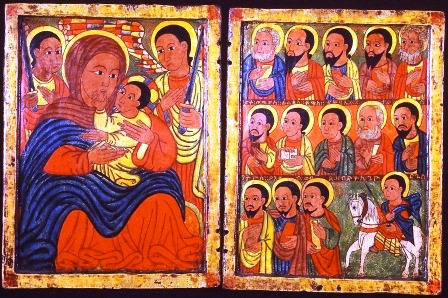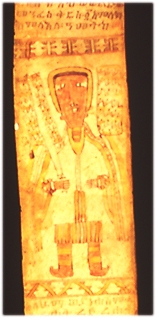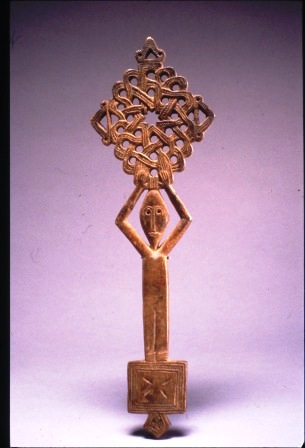Tadias Magazine
By COLLEEN LUTOLF
New York – (Tadias) – Walters Art Museum Director Gary Vikan’s fascination with Ethiopian Orthodox Tewahedo Christian art began in a Washington D.C. basement during the 1960s.
——————————————————————————————–
Listen on WNYC: Dr. Gary Vikan, Director of the Walters
Art Museum, talks about the significance of Ethiopian
religious icons and other objects of worship on display
at the Museum of Biblical Art.
——————————————————————————————-
“I do remember going into somebody’s house in Washington [D.C.] and seeing the Virgin [Mary] with these huge, dark eyes,” Vikan said during a recent interview. “And I remember the moment I saw it and where I was standing. The memory is very strong.”
Private collections throughout the world, like those protected beneath a Washington D.C. house, inside rock-hewn Christian monasteries in Ethiopia, or above ground in a New York City SoHo loft, have provided the Walters Art Museum with a majority of its Ethiopian Orthodox Tewahedo Christian art, Vikan said.
Vikan only began collecting Ethiopian Orthodox Christian art for the Walters in 1993, the same year he curated “African Zion: The Sacred Art of Ethiopia,” an historical exhibition he said served as a “flashpoint” for the current strife occurring in Ethiopia at the time.
“In the context of doing the exhibition, it was not easy. It was a troubled moment historically” in Ethiopia, Vikan said, with Mengistu Haile Mariam’s reign of Red Terror having just ended. The trial that would prosecute members of the communist Derg, mostly in absentia, would soon begin.
“These aspects put people on edge, and they kind of spilled over, not into the exhibition itself, but the different views, it was very interesting,” he said. “The exhibition had facets that most exhibitions don’t have.”
A year later, Vikan, a medieval orthodox art scholar and trained Byzantinist, moved from chief curator to director of the Walters and began collecting Ethiopian Orthodox Christian art in earnest. The Walters now boasts the largest collection of this type of Ethiopian devotional art outside of Ethiopia in the world.
“Certainly the best, from some very interesting private collections,” Vikan said. “I was attracted to it before anyone paid much attention to it.”
When the collection of a sub-Saharan art dealer who passed away was being sold off, Vikan got a call.
“Somebody selling off the collection who knew about me – this would’ve been in 1995 in New York in a loft in SoHo – they invited me down to look at this and I thought, ‘This is really amazing,’” Vikan recalled. A stock market windfall allowed Vikan to buy a number of those pieces for the Walters, and they are now included in the museum’s 100-piece collection of metalwork, icon painting, woodcarvings and ancient manuscripts that span 1,500 years of Ethiopian Christian devotion. The collection is now the central exhibit on the medieval floor of the Walters Art Museum.
“It’s in the pride position because it is so visually powerful that nothing else could dominate it,” Vikan said. “It dominates the Byzantine art around it.”
The Ethiopian Orthodox Christian collection also shares the medieval floor with Russian, Byzantine, and Georgian Orthodox art in the Baltimore museum.
“The others revolve around Ethiopia,” Vikan said. “It would make the room look funny [if they didn’t] because the others are not as visually strong.”
New Yorkers were recently given an opportunity to view about half of the Walters’ collection when the Museum of Biblical Art in New York City hosted “Angels of Light: Ethiopian Art from The Walters Art Museum” from March 23 through May 20.
If museum-goers had a feeling they were being watched as they entered the “Angels of Light” exhibition at the MOBIA, they had good reason. Huge, dark eyes similar to those that greeted Vikan in that Washington D.C. basement over 40 years ago were looking out from various devotional icon paintings depicting Jesus Christ and the Virgin Mary, almost always flanked by angels with equally large eyes that symbolize holiness.

Above: Anonymous painter. Triptych with Virgin and Child
Flanked by archangels, scenes from the life of Christ,
apostles and Saint George and Saint Mercurius. Ethiopia
(Gojjam?), late 17th century. Tempera on panel. 14 78 x
4 5/16 inches left; 15 1/8 x 9 inches center; 15 1/16 x 4
7/16 inches right. 36.7 museum purchased, the W. Alton
Jones Foundation Acquisition Fund, 1996, from the Nancy
and Robert Nooter Collection.
Most of the iconic paintings date between the 15th to 17th centuries in diptychs and triptychs depicting familiar Christian scenes – Christ on the cross; the Virgin Mary, seated, with the Christ child holding a book in his left hand, and embraced in Mary’s left arm with the first two fingers of her right hand pointing downward; Christ with a crown of thorns, Christ teaching the apostles.
While the compositions of these depictions can be traced to visiting missionaries and artists carrying with them Byzantine and Western examples of Christian iconic devotional paintings after the 14th century, the Ethiopian depictions are unique from any other depiction of Christian scenes in the world, MOBIA curator Holly Flora said.
“Ethiopian Orthodox Christianity has a very close relationship to angels that is not always found elsewhere,” said Flora. “Objects relating to healing as well are emphasized in Ethiopian art.”
Also unique to the art of Ethiopian Orthodoxy is the artists’ use of vibrant colors in paintings and manuscripts.

Above: Diptych with Virgin and Child flanked by archangels, apostles,
and Saint George. Ethiopia, late 15th century. Tempera on panel.
To understand what makes Ethiopian Orthodox Christian art unique, one must understand the role African traditional religions and Judaism played in Ethiopian culture prior to the introduction to Christianity, said Ayele Bekerie, assistant professor at Cornell University’s Africana Studies and Research Center.
“The influence of ancient religious traditions are manifested in what we now call Ethiopian Christianity, particularly in reaching out to angels and visualizing the biblical stories in colors and styles inspired by the material culture and environment,” Bekerie said. “It is important to note that most monasteries and some churches are built on top of hills and mountains where you experience remarkable and colorful views of the sunrise and sunset. Besides, the landscape is always a panorama of rainbow colors.”
Ethiopian Christianity also evolved out of a Judaic culture as well, established over 3,000 years ago. Bekerie tells the story:
“Judaism is introduced to Ethiopia at the time of Empress Makeda (She is also called Azeb and Queen of Sheba) and her son, Menelik I, the founder of the Solomonic Dynasty in Ethiopia. According to Ethiopian oral tradition, Empress Makeda paid a visit to King Solomon in Jerusalem where she made a deliberate journey in order to learn from the reported wisdom of the king. She did achieve her objective and even more by giving birth to Menelik, the son of the king. Menelik’s rite of passage was to travel to Jerusalem to meet with his father. The overjoyed king asked him to become the king of Israel, but the son wanted to return back to Ethiopia.”
“His return (there are many versions) resulted in the establishment of Judaism (a new tradition of believing in one God) in Ethiopia with the most important sacred symbol of the Ark at the center of the new belief system. When later on, Christianity emerged in Ethiopia, we observe a logical evolution of the faith from Judaism. This is because the Ethiopian Christianity is the only Christianity in the world that embraces and holds the Ark of the Covenant as its defining sacred symbol.”
“Ethiopians believe the Ark of the Covenant is in Ethiopia,” Flora said. “They will tell you unequivocally the Ark is there.”
Ethiopians believe the Ark is located in the Aksumite Church of Our Lady Mary of Zion, but every church in Ethiopia and throughout the world must have a replica of the Ark in order affirm their legitimacy, Bekerie said.
Ethiopia is one of the oldest Christian civilizations in the world. The religion was practiced along the Ethiopian coastline as early as 42 A.D., Bekerie said, after a Meroë (in what is modern day Sudan) merchant introduced commoners to the religion. Due to the inclusive nature of African traditional religions, Christians were able to worship openly without fear of persecution.
Perhaps more significantly, Ethiopia became one of the first countries in the world to take Christianity as its state religion approximately 300 years later when, according to legend, Frumentius, a Christian merchant seaman from Tyre on his way to India with relatives, became shipwrecked and was delivered to the king in Axum, a powerful world empire in the fourth century, Bekerie said.
“He was raised with special care and managed to master the language and traditions of the Aksumites,” said Bekerie. When the king’s son Ezana, came to power, the long-trusted Frumentius convinced him to make Christianity the state religion.
Proof of the conversion is part of the Walters Art Museum collection. Two silver coins, slightly larger in diameter than a pencil eraser, and crafted in the 4th century, show on one side the likeness of Aksumite King Ousanas, on the other, a cross. Aksumite coins are the first in the world to carry the cross, pre-dating Constantinople.
African traditional religious practices were also incorporated into the Ethiopian Orthodox Christian religion.
Protective scrolls, made for those who were ill or believed to be possessed by demons, were created (and still are today in some remote villages, Flora said), by clerics known as däbtära. The däbtära would sacrifice a goat, sprinkle the ill or those believed to be possessed with the goat’s blood, then fashion the scroll from the sacrificed goat’s skin, Flora said.
A healing scroll from the 18th century obtained by the Walters Museum and on display there, was created for a woman named “Martha.” The scrolls combined Christian imagery with magical incantations written in Ge´ez, a liturgical language developed in Ethiopia in the 4th century. The incantations were book-ended by talismans drawn at the top and bottom of the scroll and are believed to protect their owners, Flora said. The scrolls’ recipients then wore the prayer scrolls until they were believed healed.

Above: Prayer Scroll. Ethiopia,
19th century. Ink on parchment.
65 9/16 x 3 7/16 inches. W.788,
gift of Mr. James St. Lawrence
O’Toole, 1978.
Another prayer object that is unique to Ethiopian Orthodox Christianity and features the well-honed abilities of Ethiopian metalworkers are processional crosses. Draped in purple textiles, the MOBIA featured six such crosses, almost six feet in height, dating as far back as the 13th century. Made of gold or silver, these crosses are carried by priests during processions and feature intricate geometrical patterns, Flora said.
“Priests carried these during mass and also used them as instruments of blessing,” she said.

Above: Hand Cross. Ethiopia, 18th–19th century.
While Ethiopian artists were almost unquestionably influenced by Western and Byzantine devotional icon painting in the 15th century, due in part, museum curators suggest, to the destruction of many church murals and liturgical objects during the Muslim invasions of the 1530s and 1540s, Bekerie said some observers are too quick to see overt Western influence in Ethiopian artists’ creative thought.
“It seems to me there is some sort of mental block not to acknowledge originality and creativity in the Ethiopian artists,” he said. “I always advise scholars to use the example of the architecture of the Debre Damo Monastery, the oldest monastery in Ethiopia.”
The monastery is constructed of stone blocks and logs, creating a distinct architectural feature, Bekerie said. Distinct painting traditions have also emerged in different regions of Ethiopia and are pursued by students over the centuries.
The monarchy and the Ethiopian Orthodox Tewahedo Christian Church were institutional pillars that guided culture and politics in Ethiopia until the monarchy’s fall in 1974, Bekerie said.
“The monarchy is gone and the church is still place,” he said. “It is true that there are other religious institutions, including Islamic, Catholic and Protestant institutions. The oldest and by far the most influential is the Tewahedo Church. [Its] influence is apparent in art, music, social relations, food habits and literature.”
And as the collection of Ethiopian art becomes more popular, the sources for these collections become fewer, said Vikan.
“All of it’s drying up and that’s a good thing,” he said. “We need this art to be shown outside of the country, but [its distribution] needs to be controlled and shown in a way that acknowledges the dignity of the culture from which it comes.”
—
About the Author:
Colleen Lutolf is a reporter for Tadias Magazine.
Am wondering if there is anyone at the walters museum who could possibly translate a ethiopian painting that i have,the painting has been painted on some kind of animal skin.Is it possible for me to send a photo to an address of the painting.It seems to be telling the story of a king and queen or some people of importance.I belive that it is written in geeze,i would appreciate any help where possible.
Thanks very much
Carlos
Hi
I like what you have done– looking for black stations of the cross — any suggestions?
Thanks for you help
Peace
Bill
Hello, my family seem to have a (diptychs) made from the mount of olives. I think it is 15th century by the information we have been finding from the internet. I have photos of the object & wondered who i could contact to get more details. Many thanks for anyones help.